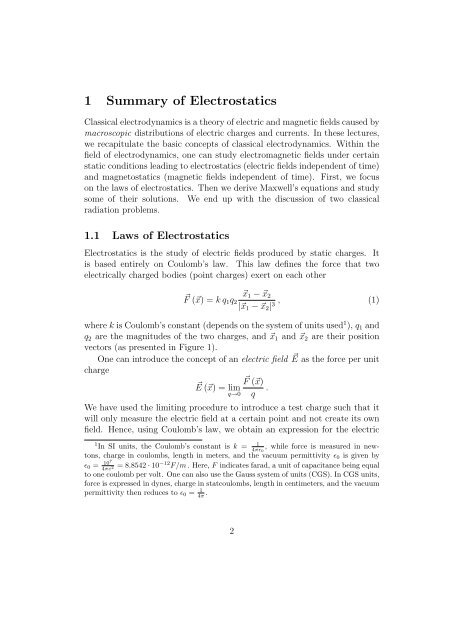Topics in Classical Electrodynamics
Topics in Classical Electrodynamics
Topics in Classical Electrodynamics
You also want an ePaper? Increase the reach of your titles
YUMPU automatically turns print PDFs into web optimized ePapers that Google loves.
1 Summary of Electrostatics<br />
<strong>Classical</strong> electrodynamics is a theory of electric and magnetic fields caused by<br />
macroscopic distributions of electric charges and currents. In these lectures,<br />
we recapitulate the basic concepts of classical electrodynamics. With<strong>in</strong> the<br />
field of electrodynamics, one can study electromagnetic fields under certa<strong>in</strong><br />
static conditions lead<strong>in</strong>g to electrostatics (electric fields <strong>in</strong>dependent of time)<br />
and magnetostatics (magnetic fields <strong>in</strong>dependent of time). First, we focus<br />
on the laws of electrostatics. Then we derive Maxwell’s equations and study<br />
some of their solutions. We end up with the discussion of two classical<br />
radiation problems.<br />
1.1 Laws of Electrostatics<br />
Electrostatics is the study of electric fields produced by static charges. It<br />
is based entirely on Coulomb’s law. This law def<strong>in</strong>es the force that two<br />
electrically charged bodies (po<strong>in</strong>t charges) exert on each other<br />
⃗F (⃗x) = k q 1 q 2<br />
⃗x 1 − ⃗x 2<br />
|⃗x 1 − ⃗x 2 | 3 , (1)<br />
where k is Coulomb’s constant (depends on the system of units used 1 ), q 1 and<br />
q 2 are the magnitudes of the two charges, and ⃗x 1 and ⃗x 2 are their position<br />
vectors (as presented <strong>in</strong> Figure 1).<br />
One can <strong>in</strong>troduce the concept of an electric field E ⃗ as the force per unit<br />
charge<br />
F ⃗ (⃗x)<br />
⃗E (⃗x) = lim .<br />
q→0 q<br />
We have used the limit<strong>in</strong>g procedure to <strong>in</strong>troduce a test charge such that it<br />
will only measure the electric field at a certa<strong>in</strong> po<strong>in</strong>t and not create its own<br />
field. Hence, us<strong>in</strong>g Coulomb’s law, we obta<strong>in</strong> an expression for the electric<br />
1 In SI units, the Coulomb’s constant is k = 1<br />
4πɛ 0<br />
, while force is measured <strong>in</strong> newtons,<br />
charge <strong>in</strong> coulombs, length <strong>in</strong> meters, and the vacuum permittivity ɛ 0 is given by<br />
ɛ 0 = 107<br />
4πc<br />
= 8.8542 · 10 −12 F/m . Here, F <strong>in</strong>dicates farad, a unit of capacitance be<strong>in</strong>g equal<br />
2<br />
to one coulomb per volt. One can also use the Gauss system of units (CGS). In CGS units,<br />
force is expressed <strong>in</strong> dynes, charge <strong>in</strong> statcoulombs, length <strong>in</strong> centimeters, and the vacuum<br />
permittivity then reduces to ɛ 0 = 1<br />
4π . 2
















